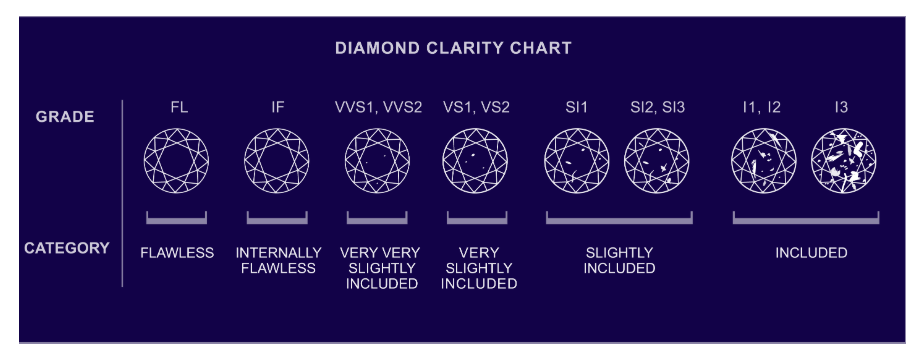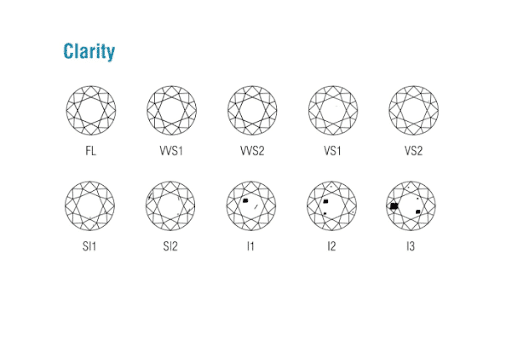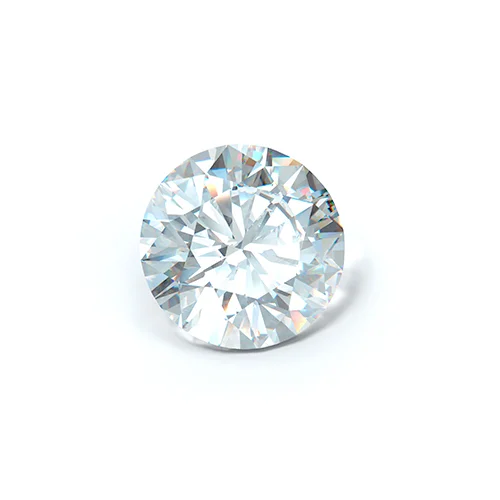What Is Diamond Clarity?
One of the most important factors to consider when purchasing a diamond is its clarity. Simply explained, diamond clarity refers to the presence or absence of internal and exterior qualities such as inclusions and blemishes in a diamond. These qualities define a diamond’s clarity grade, which has a significant influence on its overall beauty and value.
It is critical to understand diamond clarity since it has a significant impact on the look and quality of a diamond. Inclusions and imperfections, which can vary in size and position, can diminish a diamond’s brightness and shine. As a result, a diamond with excellent clarity is more precious and attractive.
When searching for an engagement ring or other diamond jewellery, consider the clarity of the diamond as well as the shape, colour, and carat weight. Understanding diamond clarity and the clarity scale will assist you in making an educated selection and choose a diamond that suits your individual demands and preferences.
Explained Diamond Clarity Scale Grade
The Diamond Clarity Scale is a grading method for diamond clarity based on the number, size, and position of inclusions and imperfections inside the diamond. The scale usually runs from Flawless (no obvious inclusions or defects under 10x magnification) to Included (heavily included and easily visible to the naked eye). The following are the most often used clarity grades:

Flawless (FL), Internally Flawless (IF)
Internally Flawless (IF) diamonds may have exterior features (also known as flaws) that are exceedingly difficult to see at 10x magnification on the stone’s surface, if at all, whereas Flawless (FL) diamonds have no inclusions or blemishes when examined under 10x magnification.
Very Very Slightly Included (VVS1, VVS2)
Although the name may appear redundant, Very Very Slightly Included (VVS1, VVS2) diamonds are given this designation because, unlike their Flawless or Internally Flawless counterparts, they do contain inclusions that are so small that they are difficult to spot under the 10x magnification used by expert gemologists to determine a stone’s clarity.
Very Slightly Included (VS1, VS2)
VS1 and VS2 diamonds, like their higher-graded counterparts, contain minute inclusions such as clouds, crystals, or feathers; however, unlike Very Very Slightly Included diamonds, the inclusions in Very Slightly Included stones are only marginally difficult to locate with 10x magnification, rather than being extremely difficult.
Slightly Included (SI1, SI2, SI3)
Slightly Included diamonds (SI1, SI2, SI3) include inclusions that are visible to the naked eye, including as clouds, knots, crystals, caverns, and feathers, even without 10x magnification. Without magnification, the presence of inclusions, no matter how prominent or numerous, is what defines whether a diamond is Slightly Included or Fully Included.
Included (I1, I2, I3)
Included diamonds (I1, I2, I3) have highly noticeable inclusions that can generally be detected with the naked eye and even more so under 10x magnification. Excess clouds, feathers, knots, cavities, and crystals big and deep enough to be mistaken for smudges or fissures can cause included diamonds to lose transparency and brightness. Included diamonds, although having these flaws, are nevertheless able to sell well enough, despite being regarded less attractive than a better clarity rated stone.
It is crucial to remember that the clarity grade of a diamond does not primarily define its beauty or quality. If the inclusions and blemishes are placed in regions that are not immediately apparent to the human eye, a diamond with a lower clarity grade can nevertheless have great sparkle and brilliance.
How Diamond Clarity is Graded

The procedure of grading diamond clarity is systematic and based on a standard established by the International Gemological Institute (IGI). A diamond’s clarity is assessed using a 10x magnification procedure, which allows the jeweller to precisely study the stone and discover any imperfections or flaws. The IGI Clarity Grading System classifies diamonds into six grades, from Flawless (FL) to Included (I) (I3). A diamond’s grade is determined by the size, position, and amount of flaws and imperfections it contains. This approach ensures that diamonds are regularly and precisely appraised, and also assists customers in understanding the clarity of a diamond.
Factors That Affect Diamond Clarity
A variety of variables influence diamond clarity, including the presence and appearance of inclusions and imperfections inside the diamond. Some of the most important elements influencing diamond clarity are:
- Nature of The Formation Process: The manner in which a diamond is created can influence the amount and size of inclusions and imperfections present. Some diamonds develop at high pressures and temperatures, whereas others form more slowly and at lower temperatures.
- Type of inclusions and blemishes: Inclusions and imperfections in diamonds can include crystals, feathers, clouds, and knots, each of which has a distinct affect on clarity.
- Location of inclusions and blemishes: The position of inclusions and imperfections within a diamond can have a significant influence on its clarity. Inclusions and imperfections found towards the centre or near the surface of the diamond are often more apparent than those placed on the perimeter.
- Cut and polish of the diamond: When opposed to a badly cut or poorly polished diamond, a well-cut and well-polished diamond would often have less obvious imperfections and blemishes.
Understanding the factors that affect diamond clarity allows you to make an informed decision when purchasing a diamond and choose a diamond that suits your individual needs and tastes.
How Diamond Clarity Grade Affects Price
Diamond clarity is an important component in evaluating a diamond’s value. The clarity grade, size, position, and amount of flaws and imperfections all have an influence on the quality of a diamond. A diamond with a SI1 clarity grading, for example, can nevertheless be deemed high-quality if the inclusions are minor and not immediately visible. A VS1 diamond, on the other hand, may be deemed low-quality if it has big, visible inclusions.
If you want a high-quality diamond with maximum aesthetic appeal, pick a diamond with a clarity grade of VS2 or better. If you are on a tight budget, choose a diamond with a clarity grade of SI1 or SI2, which can provide good value for money.
When it comes to selecting the correct clarity grade for your diamond, bear in mind that there is no one-size-fits-all solution. Working with a professional and reputable jeweller who can help you analyse the clarity of different diamonds and pick the best option based on your unique needs and tastes is the best method.
Choosing a Diamond with the Right Clarity for You
Choosing the proper clarity for a diamond may be a balancing act between clarity and price. When making this selection, it is critical to understand the trade-off between clarity and carat weight.
A diamond with a high clarity grade, such as VS1 or better, may be the best option for people who value clarity. However, these diamonds are frequently more expensive. Diamonds of lesser clarity grading, such as SI1 or SI2, might be more affordable but may have obvious flaws or imperfections.
When making your selection, keep your particular tastes and budget in mind. A better clarity grade may be the way to go if you want a diamond that will dazzle and shine. If you are working with a limited budget, you may choose a diamond with a lesser clarity grade and focus on a bigger carat weight to compensate for the difference in clarity.
The clarity grade you choose is determined by what is essential to you and how much you are prepared to spend. A competent and trustworthy diamond jeweller can assist you in navigating the process and making an educated selection that matches your unique needs and tastes.
Final Thoughts
Understanding diamond clarity is crucial when selecting a diamond for a special occasion, such as an engagement ring. By using the clarity chart and considering factors such as the size, location, and number of inclusions and blemishes, you can make an informed decision that balances clarity and price. It is important to work with a knowledgeable and trusted jeweler who can guide you through the process and help you choose the right diamond with the right clarity for you.
Get the best deal on loose diamonds at wholesale prices from Diamond Registry. Get a free quote today and take the first step towards finding your perfect diamond!

